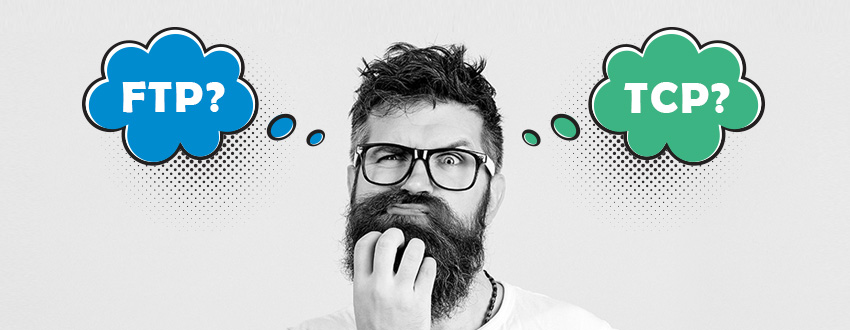
FTP vs. TCP
FTP and TCP are two common terms that get tossed around often in the virtual world. While they both serve their purpose of exchanging sensitive data, they vary in notable ways.
What is FTP?
The original file transfer protocol, FTP, is a standard network protocol that has been around for decades and is used for the transfer of sensitive files between a client and a server on a computer network. It can be used to exchange and manipulate files over a TCP/IP based network, like the Internet.
With FTP, user credentials are sent as plain text and files are not encrypted when they are transferred. With both channels unencrypted, FTP leaves data vulnerable to being intercepted and taken advantage of.
Related Reading: FTP, FTPS, & SFTP: Which Protocol Should You Use and When?
What is TCP?
TCP, short for Transmission Control Protocol, is a communication standard that enables application programs and computing devices to exchange data and/or messages over networks. It is included within the standards defined by the Internet Engineering Task Force (IETF).
This protocol defines how to establish and maintain a network connection through which data is then exchanged. It also determines how to break the application data into packets that networks can transfer and ensures end-to-end data delivery. TCP transmission is reliable, secure, and guarantees the integrity of data sent over a network, regardless of the amount.
TCP works with the Internet Protocol (IP); IP, a principal communications protocol dictates how data should be sent over the Internet from one network to the next. Together, TCP and IP are the basic standards that define that rules of the Internet and are the most widely used protocols within the Internet protocol suite. However, many major applications rely on TCP such as file transfers (FTP), email, and remote administration.
The Difference Between FTP and TCP
FTP is a file transfer protocol, which means it is used to transfer files between a client and a server, whereas TCP is a communication protocol used to exchange data between networks.
They come together when FTP sends data over a TCP/IP connection.
Related Reading: What Are the Top File Transfer Protocols?
How Does TCP Exchange Data?
TCP is a connection-oriented protocol. This means that a connection is established and maintained until the application programs at each end have finished exchanging messages. Before it transmits data, TCP establishes a connection between a source and its destination. It then breaks large amounts of data into smaller packets, while ensuring data integrity is in place throughout the process.
TCP is used to transmit data from a variety of high-level protocols that need all data to arrive. These include peer-to-peer sharing protocols like FTP, Secure Shell (SSH), and Telnet. It is also used to send and receive email through Internet Message Access Protocol (IMAP), Post Office Protocol (POP), and Simple Mail Transfer Protocol (SMTP), and for web access through the Hypertext Transfer Protocol (HTTP).
Related Reading: Comparing Transfer Methods: HTTP vs. FTP
The TCP/IP Relationship
TCP and IP are individual protocols that work together to ensure data is delivered to its intended destination within a network. IP obtains and defines the address – the IP address – of the application or device the data must be sent to. TCP is then responsible for transporting data and ensuring it gets delivered to the destination application or device that IP has defined.
The two protocols are frequently used together and rely on each other for data to have a destination and safely reach it, which is why the process is regularly referred to as TCP/IP.
The TC/IP Model
The TCP/IP Model represents how data is exchanged and organized over networks. It is a concise version of the Open Systems Interconnection Model (OSI Model) and is made up of four layers. These layers are:
1. Application Layer
The purpose of the Application Layer is to interact with software applications to implement a communicating component. It helps to identify communication partners, determine resource availability, and synchronize communication.
2. Transport Layer
The Transport Layer determines how much data should be sent where and at what rate. It builds on the message(s) received from the Application Layer and helps to ensure that data units are delivered error-free and in sequence. This layer helps to control the reliability of a link through flow control, error control, and segmentation or de-segmentation. TCP is the best-known example of the Transport Layer.
3. Internet Layer
The Internet Layer is responsible for the logical transmission of data packets over the Internet to the Network Interface Layer. It routes each of the data packets independently, reassembles the out-of-order packets when they reach the destination, and handles the error in transmission of data packets.
4. Network Interface Layer
The Network Interface Layer helps to define details of how data should be sent using the network. It defines how the data should be sent physically and is responsible for the transmission of the data between two devices on the same network.
Transfer Files With Our Free FTP Client & Server
A powerful FTP Client and enterprise-level FTP Server are both available for your use with the free edition of GoAnywhere Managed File Transfer (MFT).
Set up and automate FTP transfers through an intuitive browser-based interface, get access to 5 Secure Mail and 5 GoDrive users, collaborate with clients, encrypt data, and more.
